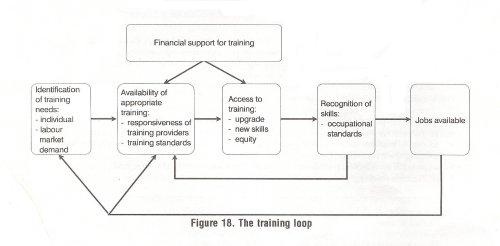
Training
A well-integrated training system aimed at facilitating transitions into employment must:
We believe that training alone does not create jobs and that policies to promote job creation must be in place so that the economy generates an appropriate number of meaningful jobs.
The training loop (Figure 18) illustrates how the various elements that need to be taken into consideration interact in a functioning training system and the necessary feedback as the labour market evolves. This figure will guide our investigation of the training issue.

Training received much attention from the CLMPC task forces on labour force development strategies (CLMPC, Ottawa, 1990). They identified a need for more relevant, flexible, and accessible training in a wider variety of occupations and delivery modes.
There is a widely shared sense that skills are becoming obsolete more quickly and that, as a consequence, training as a lifelong process has become a necessity for workers and society in general.
The need for training is an outcome of economic development, the setting of occupational standards (labour market demand), and individual needs. Presently, in Canada, the training offered by training institutes is traditional and workplace training is poorly distributed, with the more educated benefiting most from employer-based training.